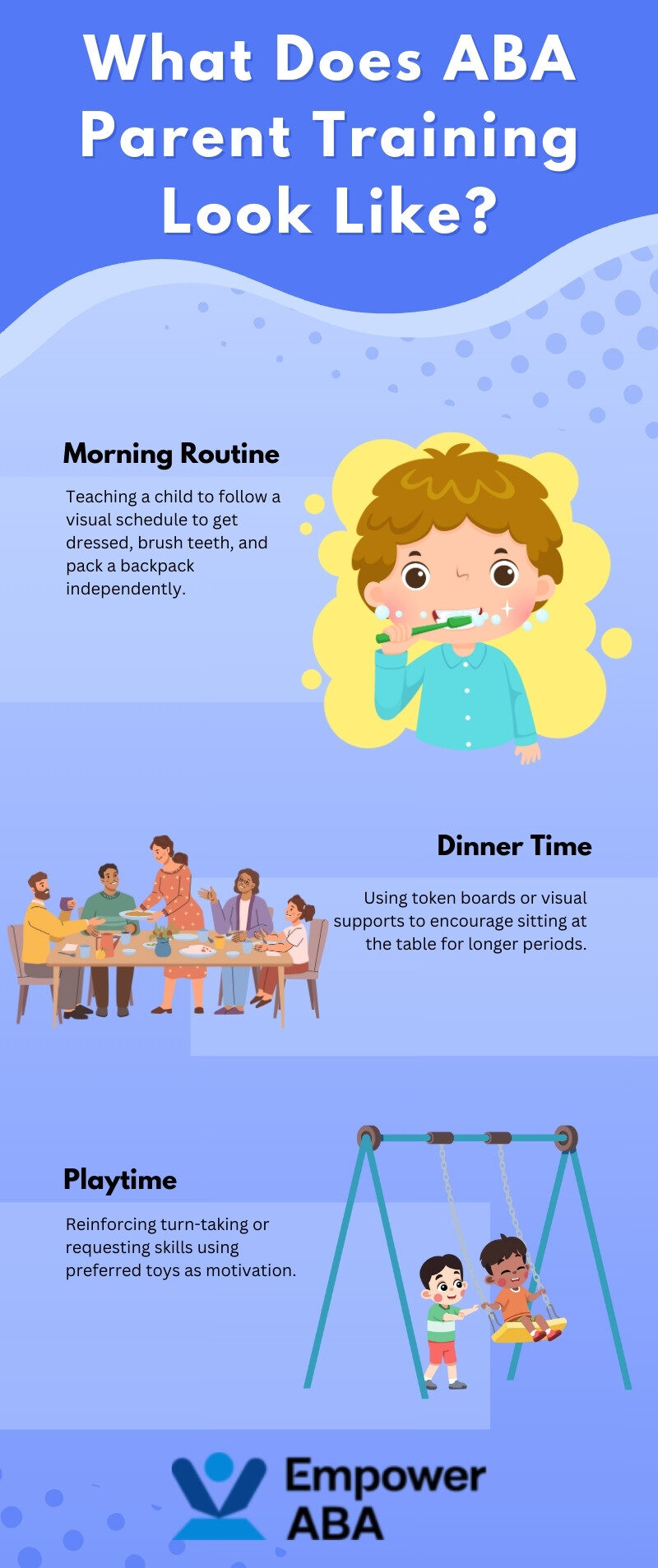Key Points:
- Real-life parent training ABA examples help families apply therapy strategies at home and in the community.
- Each scenario provides insight into how to reinforce behavior plans, manage challenges, and build skills.
- Effective ABA parent training empowers caregivers to feel confident in supporting their child’s growth outside of therapy sessions.
You want to help your child communicate, stay calm, and succeed—but figuring out how can be overwhelming. That’s why ABA parent training focuses on giving you clear, realistic tools to use every day. In this guide, we’ll walk through relatable scenarios that show what really works—and how you can do it too.
Why Is Parent Training in ABA Important?
ABA therapy isn’t something that happens in a bubble. While ABA therapists often work directly with children, real progress happens when parents can generalize those lessons across daily life. Parent involvement is critical for long-term success.
For a child on the autism spectrum or with behavioral needs, skills learned during sessions need to carry over to the real world—mealtimes, bedtimes, the grocery store. That’s where trained parents come in. With the right coaching and support, they can turn everyday moments into learning opportunities.

For instance, during brushing teeth, a parent might use “first-then” language: “First brush your teeth, then we read your favorite book.” If the child complies, the book acts as reinforcement, making it more likely the child will follow through next time.
How Can Parents Reinforce Communication Skills at Home?
Many ABA goals focus on improving communication, whether a child uses speech, sign language, or an AAC device. Parent training makes sure these skills are encouraged consistently outside the clinic.
Without reinforcement at home, communication skills can stall or fade. ABA training teaches parents to create natural opportunities for children to communicate their needs, make choices, and express themselves.
Below are some strategies parents might use:
- Temptations (Communication Temptations): Putting favorite snacks or toys slightly out of reach to encourage a child to ask for help or label what they want.
- Modeling language: Repeating and expanding on what the child says. If the child says “ball,” the parent might say, “Yes, red ball!”
- Prompting and fading: Giving cues to help the child communicate, and slowly reducing those cues over time as independence builds.
A simple example: At snack time, a parent might hold up two choices—apple or crackers—and wait for the child to point, sign, or say what they want. Each success gets praised, building confidence and connection.
What Role Do Parents Play in Positive Reinforcement?
Positive reinforcement is one of the cornerstones of ABA, and parents are in the perfect position to use it all day long.
Unlike punishment-based systems, ABA focuses on encouraging the behaviors we want to see more of. That might be using gentle hands, following directions, or asking nicely. Parents learn to spot those behaviors and reward them quickly and meaningfully.
Here is how parents may reinforce positive behavior:
- Behavior-specific praise: Instead of “Good job,” say “I love how you cleaned up your toys!”
- Token economies: Letting the child earn small rewards for completing tasks or using expected behaviors.
- Choice-making: Offering controlled choices gives kids a sense of autonomy while still meeting goals.
If a child struggles with transitions, a parent might say, “After putting on your shoes, you can choose a sticker.” This not only motivates the child but also builds the understanding of sequencing and consequences.
How Is Parent Progress Measured in ABA Training?
Just like children with autism have goals in ABA, parents often do too. These goals focus on how well caregivers are implementing strategies and how confident they feel doing so.
ABA professionals might measure these things:
- Implementation fidelity: How accurately a parent uses a specific strategy (e.g., token boards or prompting).
- Engagement levels: Are parents participating actively in sessions and asking questions?
- Parent feedback: Therapists ask how comfortable the parent feels and what challenges they’re facing.
Training isn’t about perfection—it’s about progress. Therapists often use checklists, video modeling, or role-play scenarios to guide and assess parent involvement. This ensures consistency between home and therapy sessions and identifies areas for further support.
How Can ABA Parent Training Help in Public or Social Settings?
Therapy doesn’t end at the doorstep. Outings like going to the grocery store, dentist, or family events can trigger stress or behaviors. ABA parent training offers practical strategies for navigating these spaces.
Real-life examples make training relatable—and effective. By practicing in settings where challenges actually occur, parents get hands-on experience applying strategies with coaching support.
Build Real-World Skills with Empower ABA
Parent training in ABA works best when it’s personalized, supportive, and embedded into everyday life. At Empower ABA, we believe that parents are the key to unlocking lasting progress for their children. That’s why our team goes beyond the clinic, offering comprehensive ABA therapy in New York, New Jersey, and Virginia—with parent training that’s practical, compassionate, and designed to meet families where they are.
If you’re ready to feel more confident, more connected, and more in control of your child’s development journey, let’s work together. Empower ABA is here to support you every step of the way. Get in touch with us and discover how parent training can make everyday moments more meaningful!

